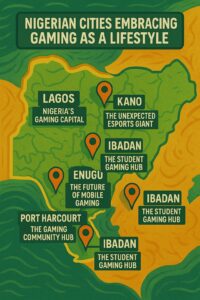Starlink’s Rental Plans in Kenya: A Game-Changer for Esports, But Is It Enough?

Starlink, the satellite internet constellation project by SpaceX, has recently announced the introduction of rental plans for its Starlink kit in Kenya. This move is poised to revolutionize the country’s digital landscape, particularly in sectors like education, remote work, and notably, esports. The prospect of high-speed, low-latency internet across Kenya, including in rural and underserved areas, is a significant development for the nation’s burgeoning esports scene. However, while the potential benefits are immense, the cost factor remains a substantial hurdle.

Unlocking Kenya’s Esports Potential
Kenya’s esports industry has been gradually gaining momentum, with a growing number of players and teams emerging on the local scene. However, one of the critical challenges has been reliable internet connectivity. Esports, by nature, demands high-speed internet with minimal latency to ensure seamless gameplay, especially in competitive settings where every millisecond counts. For Kenyan teams aspiring to compete on the international stage, the lack of adequate internet infrastructure has often been a limiting factor.
With Starlink’s satellite internet, this barrier could soon be a thing of the past. Starlink promises high-speed internet with low latency, which could level the playing field for Kenyan esports teams. Players in remote areas will no longer be disadvantaged by poor internet connections, and this could dramatically increase their chances of participating in international tournaments. By providing a reliable and fast internet connection, Starlink could open doors for Kenyan teams to compete against the best in the world, without the constraints that have historically held them back.
The Cost Conundrum
While the availability of Starlink in Kenya is a promising development, the cost associated with it remains a significant concern, especially for the esports community. Starlink’s rental plans for its kit, although more affordable than outright purchasing the equipment, still come with a considerable price tag. The minimum cost, which includes a monthly subscription fee, is still quite expensive for most Kenyan esports teams.
Currently, the esports industry in Kenya is still in its infancy, with many teams operating on tight budgets, often relying on personal funds or minimal sponsorships. External funding is scarce, and the high costs of accessing Starlink’s services could put it out of reach for many. This financial barrier could potentially limit the number of teams that can benefit from this revolutionary internet service, creating a gap between those who can afford it and those who cannot.
The Path Forward: Bridging the Gap
For Starlink’s entry into the Kenyan market to truly benefit the esports industry, there needs to be a concerted effort to make this technology more accessible. This could involve subsidies, sponsorships, or partnerships between Starlink and local organizations to reduce the cost burden on esports teams. Additionally, fostering relationships with global brands and organizations invested in the growth of esports could provide much-needed financial support to these teams.
Moreover, local government initiatives could play a crucial role in bridging this gap. By recognizing the potential of esports as a growing industry and a source of economic development, there could be policy support to make high-speed internet more affordable and accessible. This would not only benefit the esports industry but also drive digital transformation across the country.

A Double-Edged Sword
Starlink’s introduction of rental plans for its kit in Kenya is undoubtedly a significant step forward, with the potential to boost the local esports scene by providing the reliable, high-speed internet that is essential for competitive gaming. However, the high cost remains a barrier that could prevent many teams from reaping these benefits.
To fully unlock the potential of Kenya’s esports industry, it will be crucial to find ways to make Starlink’s services more accessible to all. This could pave the way for Kenyan esports teams to not only participate in but also excel in international tournaments, putting Kenya on the global esports map. For now, the industry watches and waits, hopeful that solutions will emerge to make this groundbreaking technology a reality for all aspiring esports champions in Kenya.
4o




